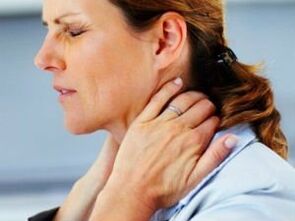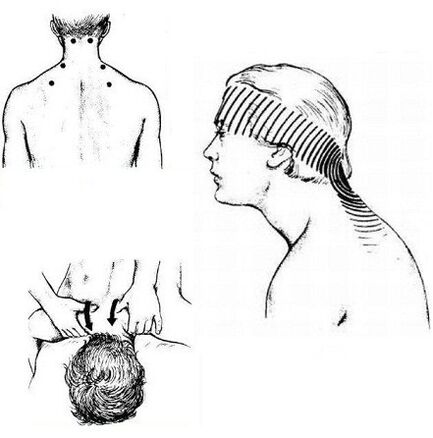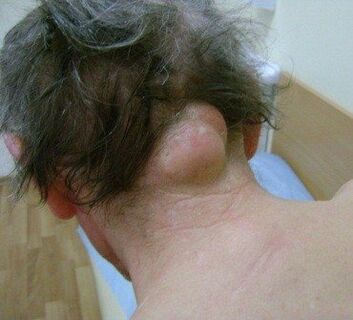
The human neck, like other animals, is a wonderful part of the body, quite fragile yet very strong.
The cervical spine, together with all the muscles and ligaments, supports and sets the movement of the skull, absorbs shocks when walking, protects the brain from concussions, protects the blood vessels that feed it and alsoprotect the spinal cord.
It could be argued that almost everyone has experienced neck pain in their lifetime. Neck pain can affect both men and women of all ages.
When the neck is sore, the reasons can be quite varied. Some may resolve on their own within a few days, and some can cause chronic and painful illness.
Why does the pain happen?
The most common reason your neck hurts is poor posture. With a stooped position, the head no longer occupies the correct position on the body and moves forward. In this position, tension in the muscles and ligaments of the neck increases. The development of stoop and neck pain is facilitated by prolonged work without changing positions, sleeping on soft beds or high pillows, prolonged static loads.
Other causes of neck pain are head injuries, traffic accidents, or sports. When accelerating sharply and then braking, the cervical spine creates a strong movement. As a result, ligaments and muscles can become overstretched, displaced or compressed fractures can occur in the cervical vertebrae, and herniated discs can form.
Neck pain can occur as a side effect of other diseases. For example, myocardial infarction, when myocardial infarction will cause severe pain, spreading along the nerve plexus to the upper extremities, chest, neck. Neck pain from a heart attack is just one part of a large spectrum of symptoms - shortness of breath, sweating, nausea, vomiting. If you experience neck or jaw pain and other signs of a heart attack, call an ambulance immediately.
Neck pain is also used as a diagnostic marker of meningitis. With this disease, the muscles of the neck become hypertonic, that is, they become rigid. When you try to tilt your head to your chest, the back neck hurts badly.
Neck pain caused by rheumatoid arthritis, osteoporosis, fibromyalgia, spondylosis and osteoarthritis, hernia or protrusion, nerve root or spinal cord compression with infectious edema, abscess, tumor or benign neoplasm.
Special case
Degenerative disease
Osteochondrosis, or in other words, dystrophic disorder in the intervertebral discs, resulting in a person's neck being constantly in pain. These are usually mild aches and pains, often accompanied by numbness and pain in the shoulders, neck, and head.
The neck area affected by osteonecrosis can cause the development of cerebral artery syndrome. With a decrease in the intervertebral disc space in this area, a compression injury to the vertebral arteries occurs at the openings of the transverse processes of the cervical vertebrae. Pressure on the pulse causes reduced blood flow to the brain with dizziness, vision and hearing loss. On the other hand, mechanical stimulation of the artery with pressure from the vertebrae causes a reflex constriction, which manifests as a sharp pain in the head.
Treatment
If the neck is constantly in pain due to osteochondrosis, then therapy begins with the elimination of the pain syndrome. The second imperative direction of treatment is the cessation of degenerative processes in the cervical vertebrae.
Pain relief can be achieved using the following classes of drugs:
- non-steroidal anti-inflammatory drugs - directly block the flow of pain-signaling mediators;
- muscle relaxants - eliminate muscle spasms, reflexively arising from severe pain;
- tranquilizers - they calm and inhibit the nervous system and the transmission of pain impulses, including (vallerian, antidepressants, hypnotics);
- vasodilator - helps to eliminate vertebral artery syndrome and the pain associated with it.
To eliminate the cause of neck pain in osteosarcoma, chondroprotective drugs are prescribed that prevent the destruction of cartilage and vertebrae, as well as multivitamin mineral complexes.
Pain management also includes physical therapy, physical therapy, massage, traction, reflexology, and ice therapy. During an exacerbation, to relieve pain, the patient should wear a special necklace to protect the neck from excessive movement.
Muscle pain

Neck pain that can occur when the muscles in the neck become inflamed is called myositis.
Such pain should be differentiated from neuritis (neuritis with sensory disturbances) and pain from osteonecrosis.
Myositis occurs suddenly, after exposure to predisposing factors - hypothermia, vibration, prolonged exertion, especially with prolonged repetitive movements of the same type.
Cervical myositis is characterized by acute pain that occurs when the inflamed muscle contracts. The severity of the pain makes it difficult to perform certain types of movement.
Usually, the long muscles of the neck on the anterolateral surface or the sternocleidomastoid muscle are painful, when bilateral contractions pull the head back, and when unilaterally, they rotate the head.
The deep muscles that surround the spine are also often inflamed and cause the entire neck and back to move.
When probing a muscle, we notice increased tone and dense nodal regions. Violation of local circulation and nutritive properties leads to a gradual replacement of muscle cells with connective tissue. As a result, the neck muscles weaken, their symmetry is disrupted on either side of the spine, scoliosis can occur, and the patient has difficulty keeping the head straight.
Treatment
Treatment begins by reducing stress on the neck. Followed by a course of physiotherapy - hot compress with UHF machine, electrophoresis with medicine, heat with paraffin, wrap with ozokerite, sauna, massage, acupuncture. Such procedures restore blood circulation to the muscles in the neck. Among the drugs, vitamin B injections, anti-inflammatory and pain relievers, ointments and topicals are prescribed.
Alternative treatments recommend using cabbage or burdock leaves as a pain reliever, preparing an ointment from pounded willow buds in butter, making a mixture of turpentine with apple cider vinegar and egg yolks. In addition, the neck is rubbed with lava oil, and then wrapped. The main guarantee of the success of any treatment is to keep the sore neck calm until its muscles are fully recovered. After that, you should start them back on their "duty" with special massage and fitness measures.
Lens syndrome
Severe neck pain, radiating down to the muscles of the head, shoulders, neck, and upper extremities can occur when spinal nerve roots are compressed during prolapse, protrusion, or herniated disc.
With this disease, the inner nucleus of the disc protrudes toward the spinal canal or its lateral horn. Hernias and its symptoms are usually unilateral. When pressure is created on the roots of the spinal nerves, a sharp pain occurs in the internal muscles (cervical lumbago). The patient has a feeling of numbness in the lower jaw, around the ear, behind the head, shoulder blades, arms. Appears dizziness, sharp pain in the neck area when changing position from horizontal to vertical. Gradual protrusion of the disc nucleus leads to injury to surrounding tissues, inflammation, and edema. This sets the stage for inflammation of the nerve endings with the development of radiculitis, and the mobility of the neck and upper extremities is gradually limited. Long-term damage to the spinal nerves leads to paralysis or quadriplegia.
Therapy
What to do if the neck is painful due to hernia? At home, with pain syndrome, analgesics, non-steroidal anti-inflammatory drugs, hormonal drugs, muscle relaxants are taken to relieve spasms.
At the hospital, severe pain in the neck is eliminated with the help of "blockade" - the introduction of anesthetic agents on either side of the spine.
The swelling and inflammation treated with steroids can be injected directly into the hernia mass. Muscle soreness is eliminated by taking muscle relaxants.
In addition, to prevent further development of the hernia mass, I use drugs that strengthen cartilage tissue - chondroprotectors.
In many cases, therapeutic exercises and traction of the cervical spine with slight convex or protrusion help. The increase in disc space helps the disc "shrink" and relieves pressure on the nerves.
In the case of a true hernia with rupture of the annulus and prolapse into the spinal canal, surgery is required. There are several ways to get rid of neck pain through surgery:
- anterior cervical discectomy - removal of an extra piece of disc that is pressing on a spinal nerve;
- replacing the damaged disc with an artificial joint to protect the cervical spine from further destruction;
- microscopic laparoscopic resection with a posterior approach and resection of small areas of hernia through the laparoscope;
- posterior cervical cerclage through an incision in the back of the neck. The channel of action is specially expanded so that the pinching does not develop in the future.
Neoplasms

If there is a feeling of constant pain in the neck, one can suspect the presence of foreign education in this part.
Benign or malignant tumors of the neck may arise in the vertebral body, blood vessels, epithelium, connective tissue, nerves, adipose tissue, or glandular tissue.
Benign tumors (lipomas, fibromas, neuromas, osteomas, hemangiomas) are usually precisely shaped and well-defined, and rarely cause pain. The discomfort is mainly related to compression of the surrounding tissues by the tumor. Malignant neoplasms (osteoma, myeloma, lymphoma, or thyroid) have no borders, they metastasize extensively to nearby tissues. Their destructive effect on the organs causes pain sensations, the pathological condition worsens. The front of the neck can have cancer of the larynx, pharynx, mouth, thyroid gland. Patient has difficulty swallowing, swelling in the neck and face, changes in voice. If the neck flight is painful due to a bony tumor, this condition is also often accompanied by damage to the spinal cord and nerve roots on the side of the spine with the development of paralysis.
Treatment
Treatment for pain in a tumor is aimed primarily at eliminating the cause - reducing or eliminating the swelling. For this purpose, chemotherapy and radiation therapy, hardening of the vessels supplying the tumor, and surgical resection of the pathological formation are used.
Pain relief depends on pain level:
- weak painkillers;
- moderate pain relievers;
- with increasing pain, they turn to weak opiates;
- with severe pain, it is possible to relieve pain only with the help of opiates. To enhance pain relief in the neck with neoadjuvants, antipsychotics, anticonvulsants and corticosteroids are used.
Note! Neck pain can happen for many reasons. In order not to miss dangerous diseases, it is necessary first of all to visit a doctor for advice on the appearance of pain and to determine its exact source.

























